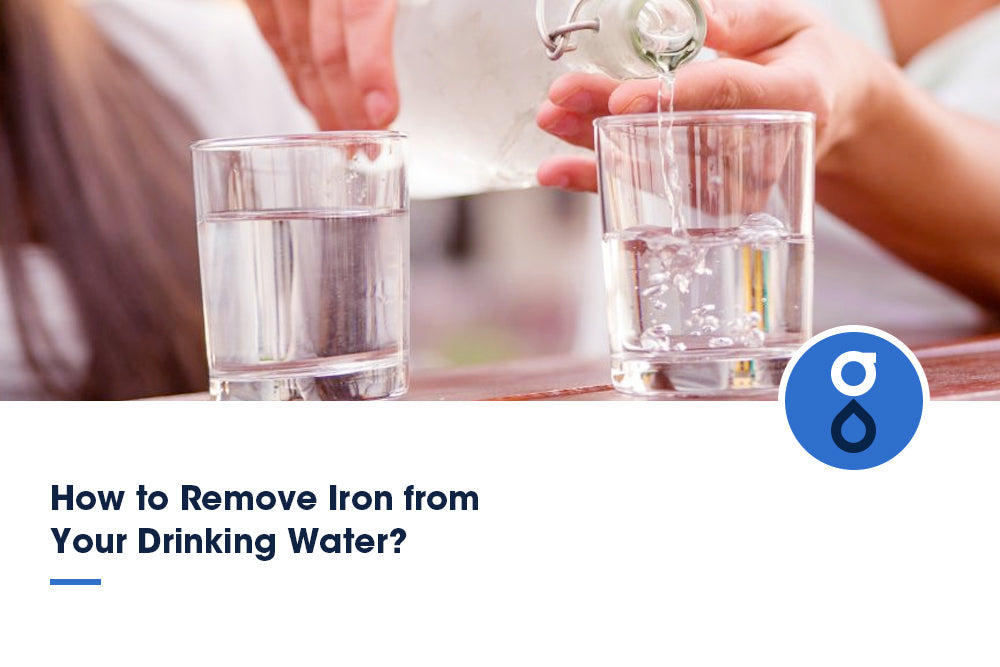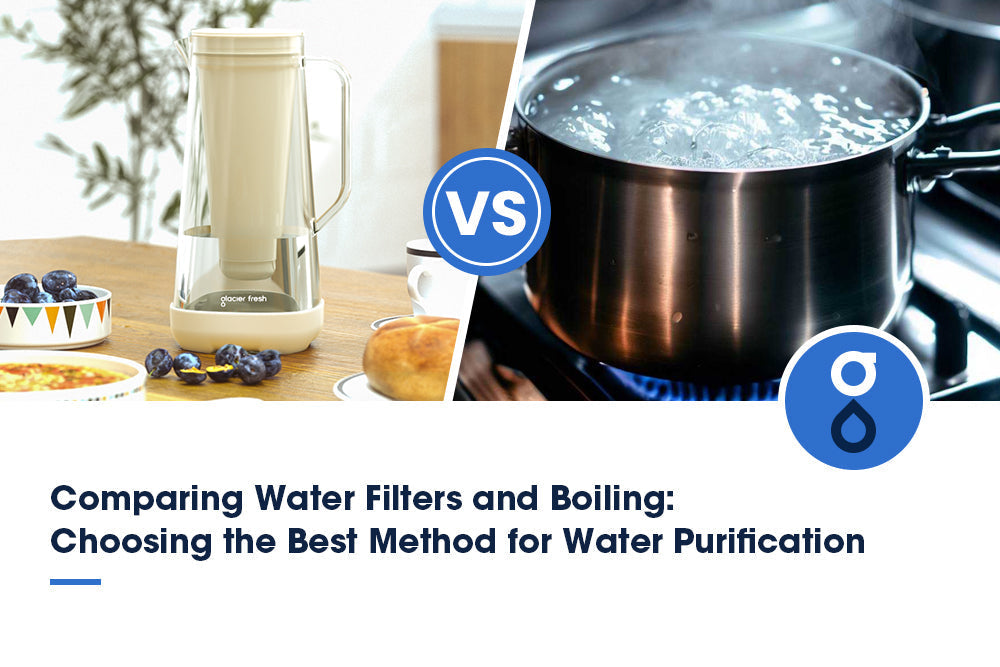Table of Contents:
What is iron?
Sources of iron in your drinking water
Types of iron found in drinking water
Signs you have high levels of iron in your drinking water
Why do you need to remove iron from drinking water?
Methods of removing iron from your drinking water
FAQs
Conclusion
Are you tired of drinking water that tastes like you've returned to the Iron Age? Well, fret no more! This guide will show you how to remove iron from your drinking water.
Iron, that pesky mineral that can leave a metallic taste in your mouth, can be a real nuisance. It can also stain your plumbing fixtures and clothing and even cause health issues if consumed at high levels. But fear not; there are effective methods to combat this problem. From filtration systems to water softeners, we'll explore the best ways to eliminate iron from your water, ensuring a clean and refreshing taste every time you take a sip. So, let's dive in and say goodbye to that rusty flavor for good!
What is iron?

Iron is a common metallic element found in the Earth's crust. It's known for its strength and ability to rust. Understanding the properties of iron is essential when it comes to dealing with its presence in drinking water. Iron can affect the taste, odor, and appearance of water, and it can also have health effects if consumed in high concentrations. That's why it's important to have iron filtration systems in place to ensure iron removal from your drinking water.
Iron removal techniques vary depending on the type and concentration of iron present. Common methods include oxidation, filtration, and ion exchange. Oxidation involves converting soluble ferrous iron into insoluble ferric iron, which can then be filtered out. Filtration systems often use activated carbon or specialty media to trap and remove iron particles. You can use various testing methods to determine the iron level in your water. These may include visual inspection, water testing kits, or laboratory analysis. Regular testing is crucial to monitor the effectiveness of your iron removal system and ensure the safety of your drinking water.
Sources of iron in your drinking water

There are several causes of iron contamination in water. One common source is natural deposits in the ground, where iron can dissolve into groundwater and find its way into your tap. Another source is corroded iron pipes and plumbing systems, especially in older homes. The iron particles can break off and mix with the water supply, leading to discoloration and a metallic taste.
While ingesting small amounts of iron isn't harmful to your health, excessive iron intake can have adverse effects. High iron levels in your drinking water can cause gastrointestinal issues, such as stomach cramps and diarrhea. It can also stain your clothes, appliances, and fixtures, making them appear rusty or discolored.
Types of iron found in drinking water
When it comes to the types of iron found in your drinking water, you may be surprised to learn that several different forms can be present. Understanding these types is important because they can have varying effects on your health, plumbing, and the overall quality of your water. Here are four common types of iron that can be found in drinking water:
- Ferrous Iron: This is also known as soluble iron and is usually found in well water. It's clear in color when first drawn, but turns reddish-brown upon exposure to air. Ferrous iron can cause health effects such as stomach cramps and intestinal issues.
- Ferric Iron: This form of iron is insoluble and appears as reddish-brown particles in the water. It can cause staining on fixtures and laundry and clog pipes and plumbing systems.
- Bacterial Iron: Iron bacteria are microorganisms that feed on iron in water, creating a slimy biofilm. This can lead to clogged pipes, unpleasant taste, and odor issues.
- Organic Iron: Organic iron is formed when iron combines with organic matter. It can cause staining, taste, and odor problems in water.
Testing for iron is crucial to determine the type and concentration in your water. Depending on the results, different iron removal methods can be employed, such as oxidation, filtration, or chemical treatment. These methods may vary for well water and municipal water sources.
Signs you have high levels of iron in your drinking water

If you suspect high levels of iron in your drinking water, there are telltale signs that can help confirm your concerns. These signs of iron contamination are unpleasant and can have adverse health effects. Testing for iron in drinking water is crucial to ensure the safety of your water supply. Here are some common signs that indicate elevated iron levels in your drinking water:

Consuming water with high iron levels can have long-term effects on your health. Iron overload can lead to severe conditions such as hemochromatosis, which affects the liver, heart, and pancreas. You can try DIY methods such as an iron filter, water softener, or aeration system to remove iron from your water. However, it is recommended that a professional be consulted to ensure the proper removal of iron contaminants. Regular testing and treatment are essential to maintain the quality and safety of your drinking water.
Why do you need to remove iron from drinking water?

Iron can have negative effects on both your health and your plumbing system. Here are a few key reasons to consider removing iron from your water:
- Health effects: High levels of iron in drinking water can lead to various health issues, such as stomach discomfort, diarrhea, and constipation. It can also affect the taste and odor of the water, making it unpleasant to drink.
- Plumbing problems: Excessive iron in water can cause rust stains on your sinks, toilets, and appliances. It can also clog pipes and reduce water flow. This can result in costly repairs and replacements.
- Water treatment options: Several effective options are available for removing iron from drinking water. These include oxidation filtration, ion exchange, and reverse osmosis. Each method has its own advantages and cost considerations.
- Benefits of removing iron: Removing iron from your drinking water can improve the taste and odor, prevent staining on your fixtures, and protect your plumbing system. It can also enhance the effectiveness of other water treatment systems you may have in place.
To ensure the safety and quality of your drinking water, it's essential to test for iron levels regularly. This will help you determine the appropriate water treatment method and minimize potential health risks or costly repairs.
Methods of removing iron from your drinking water

If you're dealing with iron in your drinking water, there are several methods you can use to remove it.
Filtration systems
One effective method for removing iron from your drinking water is utilizing filtration systems like reverse osmosis system. Filtration systems are a popular choice for iron removal techniques and are commonly used in various water treatment options. These systems pass water through a filter media that captures and removes iron particles, resulting in cleaner and clearer tap water. Here is a visual representation of different filtration systems used for removing iron from tap water:

These filtration systems are just a few examples of water purification methods to remove iron from your drinking water. Consider your specific needs and consult a professional to determine the best filtration system.
Oxidation
To remove iron from your drinking water, you can utilize oxidation methods. Oxidation is a process that involves converting dissolved iron into a solid form, making it easier to remove. Here are four effective iron oxidation techniques for treating your water:
- Aeration: This method introduces air into the water, promoting iron oxidation. As the water is exposed to air, the iron particles combine with oxygen, forming insoluble rust particles that can be filtered out.
- Chemical oxidation: Iron can be oxidized using chemicals like chlorine or potassium permanganate. These chemicals react with the iron, causing it to precipitate and settle, allowing easy removal.
- Catalytic oxidation: Catalytic media, such as manganese dioxide, can be used to accelerate the oxidation of iron. This media acts as a catalyst, speeding up the reaction between iron and oxygen.
- Ozone oxidation: Ozone gas is a powerful oxidizer that can be injected into the water to remove iron. It reacts with the iron, transforming it into solid particles that can be filtered out.
Ion exchange
You can also explore ion exchange methods to remove iron from your drinking water, which builds upon the previous subtopic of oxidation. Ion exchange is a widely used technique in water treatment for iron removal. This process involves the use of an ion exchange resin, which is typically made of polystyrene beads. The resin is charged with sodium ions, and as water passes through the resin, the iron ions in the water are exchanged with the sodium ions on the resin.
This results in the removal of iron from the water. Ion exchange is an effective method for iron removal and is commonly used in water purification systems. It's important to note that the resin needs to be periodically regenerated to maintain its effectiveness in removing iron.
FAQs
Can I remove iron from my drinking water by boiling it?
You can't remove iron from your drinking water by boiling it. While boiling water can kill bacteria and other microorganisms, it doesn't eliminate iron. If you want to remove iron from your drinking water, boiling isn't the solution.
Are there any natural methods for removing iron from water, such as using certain types of plants?
Certain types of plants can be used as natural methods for removing iron from water. Using plants for water purification is a sustainable and eco-friendly approach to eliminating iron and other contaminants from your drinking water. Some plants, such as water hyacinths, lilies, and cattails, can absorb and accumulate iron and other heavy metals in their roots and leaves. This process, known as phytoremediation, can be an effective and affordable way to treat water.
Conclusion
So, if you're experiencing high levels of iron in your drinking water, it's important to take action. Fortunately, there are several methods available to remove iron from your water. One option is to use a water softener, which can help reduce the iron content.
Another option is to install an iron filter, which is specifically designed to remove iron particles from the water. Additionally, chemical oxidizers can be used to treat the water and remove the excess iron. By addressing this issue, you can ensure that your drinking water is safe and free from any potential health risks associated with high levels of iron.
Follow Glacier Fresh to find more water filtration solutions.
















